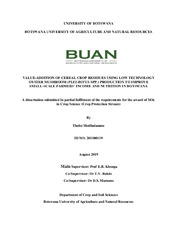| dc.description.abstract | The average cereal grain yields for Botswana small-scale farmers is 108kg/ha with gross income of P233.95/ha, respectively. The low yields are due to frequent droughts and pest outbreaks resulting in food and nutrition insecurity. Cereal crop residues are left in the fields to be grazed or harvested for feed but their income potential has not been assessed. The objectives of this study were to assess: current cereal residue use and farmers’ perceptions on incorporation of oyster mushroom production in their cereal cropping system; the additional potential farmers’ income when crop residues are used to grow mushrooms; and the nutritional composition of mushrooms grown on residues and their contribution to farmers’ nutritional status. Sixty-three farmers from southern Botswana were interviewed and crop residue biomass was estimated from 10m x 10m plots in selected farms. A 3x2x3 split-split plot factorial design experiment was used to assess biological efficiency (BE%) of three Pleurotus spp. grown on steamed and hydrogen peroxide disinfested maize, millet and sorghum stalks. Potential income was estimated using mushroom yield of the best combination of substrate, disinfestation method and Pleurotus species and nutritional analysis of mushrooms was done using standard procedures. Farmers still leave crop residues to be grazed in the field and those who harvest them for feed do not weigh them. All farmers were receptive to incorporating mushroom production in their cropping system. Residue yields of maize, sorghum and millet were 1206.7kg/ha, 1213Kg/ha and 4530.0 Kg/ha, respectively. The highest (69.4%) and lowest (8.1%) BE were recorded for P ostreatus HK35 grown on steamed millet and P. floridanus on hydrogen peroxide-treated sorghum. Average potential additional income from mushrooms grown on millet stalk was P102,695/ha compared to P233.95/ha from grain. The protein, fat and mineral content of the mushrooms was favourable and can contribute to improved diets of rural farmers. It is concluded that incorporation of oyster mushroom production in small-scale cereal production system has the potential of improving food and nutrition security among small-scale farmers and creation of jobs for unemployed youth in rural areas | en_US |

